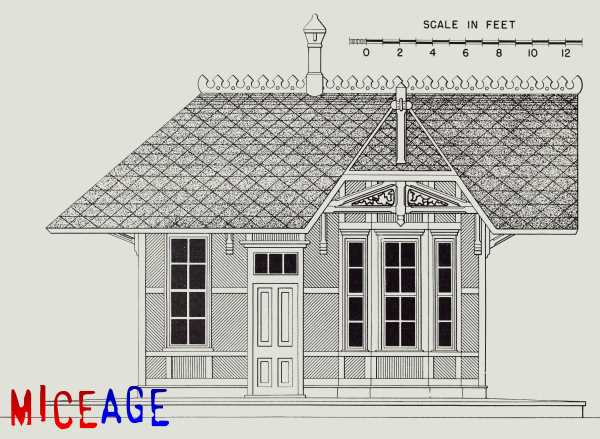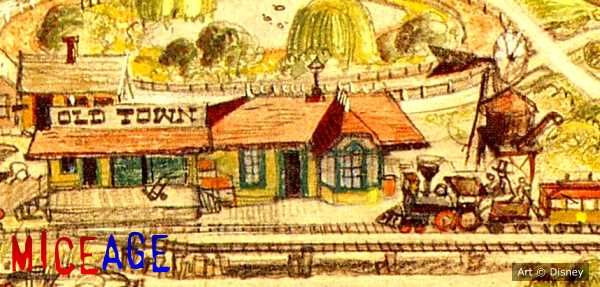|
When you arrive at Disneyland, the first structure you are confronted with
isn't a fairy tale castle or a Swiss mountain or a even a pirate ship: It's a
railroad station, not-so-subtly reminding guests of Walt Disney's great passion.
Main Street Station is nearly as iconic as Sleeping Beauty Castle, having
appeared on early post cards and even featured prominently on ticket book
covers. Its Mansard roof, clock tower and gingerbread trim bring the Victorian
era of railroading to life for 21st century Americans. But today, I want to take
a closer look at the other station that debuted along with Main Street
Station in 1955: Frontierland Station.
The Frontierland Station we've known for the past 53 years actually had its
genesis nearly seven years before Walt Disney opened Disneyland. Disney was in
the midst of filming his second feature film to use live actors, So Dear to
My Heart. The story takes place in rural Indiana around the turn of the 19th
century, and a couple of scenes revolve around a train coming into the town's
train station.
Even though the story takes place in Indiana, the film very much
reminded Walt of his old hometown in Marceline, MO. The barn used in the picture
was reminiscent of his grandmother's barn (and a design he copied for his own
backyard barn, currently on display in Griffith Park, CA). When it came time to
design the station set, you can bet Walt wanted to be involved in the process.
Where trains were involved, Walt knew his resources, and one of his best was
Ward Kimball. Kimball, an animator at the studio, shared Walt's love of trains
and railroading, and owned a large collection of railroad books and memorabilia.
When Walt went to Ward seeking some station designs to look at, Ward pulled a
huge 540 page book from his shelves, "Buildings and Structures of American
Railroads," by Walter Berg. Walt thumbed though the massive tome, studying the
detailed line drawings of stations, coaling towers, and passenger waiting sheds.
Eventually, he came to Chapter 20, entitled "Flag Depots" (flag depots are small
stations designed to alert a train to stop and pick up new orders, in the days
before radio communication). A few pages further, and there--on page 267--Walt
stopped.

A cleaned-up drawing of the station shown in Buildings and
Structures of American Railroads.
This is the very genesis of
Disneyland's Frontierland Station. Author's collection.
The entry was entitled "Frame Flag Depot, Pottsville Branch, Lehigh Valley
Railroad." The small station, designed by F.E Schall, featured a cozy bay window
where the station agent could sit, observing trains arriving and departing up
and down the track while handing out tickets to passengers. It had a large hip
roof, and decorative diagonal siding. It was just the station Walt was looking
for.

A side view of the station. Author's Collection.
Disney architects replaced the strong sloping roofline on left side of the
station with a "jerkinhead," or clipped-gable roof (such as appears over the bay
window), and soon thereafter, three sides of the station were being constructed
up where "So Dear" was filming its train scenes, in Porterville, CA (only three
sides of the structure needed to be built, as it was only a movie set piece).
After filming, Disney tore down the set pieces, and put them in storage on the
Disney lot.

The only scene in So Dear to My Heart
where the station is completely shown.
One day some time later, Walt was over at Ward's house in San Gabriel. Since
1938, Ward had been restoring an 1881 Baldwin locomotive he christened "Emma
Nevada." The Kimballs had a nice wooden engine house for their charge, and the
obligatory water tower, but Walt noticed something missing: A train station!
Walt mentioned the old set pieces for the depot from "So Dear," and asked if
Ward wanted them. Of course, Kimball replied "Yes!" and soon the Disney set
department had the pieces trucked over to Ward's place.
Ward had a concrete
foundation laid, and hired a crane company to assist with positioning the set
pieces into place. Because the painters had slopped paint over adjoining pieces
when the station was first built, Ward was able to see which piece fit where
when re-assembling the station. A back wall was built, finally enclosing the
depot, and making a real structure of the former set pieces.

Because of all the work that had to go into creating a real, solid structure
from flimsy set pieces, Ward stated that it would have been easier for him to
build a new station from the ground up! When Walt saw the completed station, he
was impressed. "Kimball...are those the set pieces I gave you?" Walt asked
incredulously.
The reconverted set pieces served Ward's "Grizzly Flats Railroad" well for
many years. In the meantime, Walt, Ward and the other early Imagineers were busy
on a new project, one that seemed to grow exponentially as time went on. The
project was called "Disneyland," and Walt had stated an edict about its design:
"It should look like nothing in the world. And it should be surrounded by a
train."
Early renderings of the park featured a train running around it. In one of the
earliest views, a station looking very much like Ward's Grizzly Flats depot was
depicted. As designs for the proposed park grew more and more complex, the small
country village initially imagined grew into a "modern" 19th century boulevard,
complete with Victorian buildings and gas lamps. Anchoring one end of this
street was the castle; at the other end was now a Mansard-roofed red-brick
Victorian masterpiece. The little frame depot had been displaced, but it would
soon appear again.

Harper Goff was clearly inspired by Ward's Grizzly Flats depot when
he drew this early rendering of Disneyland's first train station.
Walt's interest in the old west, tall tales, and his success with Davy
Crockett, naturally spurred him to create a western-themed land. Along the same
lines, his first two train sets would be themed as well--one as a 19th century
passenger train; one as an old-west freight train. The freight train would need
an appropriate frontier-themed station to call at, and so the creative team
began looking for a design. |

